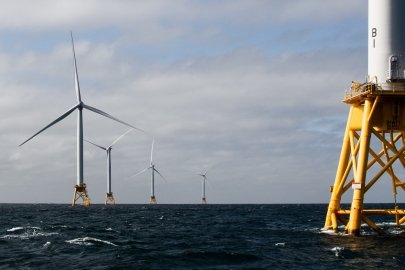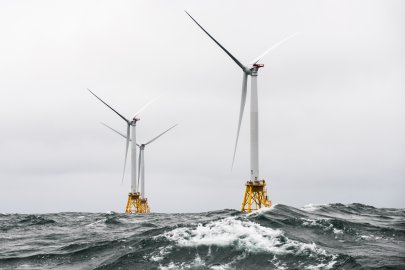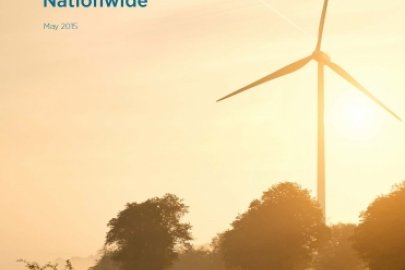The U.S. Department of Energy’s (DOE) Wind Energy Technologies Office’s mission is to fund wind energy research through technology development that will facilitate the decarbonization of our electric grid and achieve a robust U.S. clean energy economy.
WETO aims to provide abundant, low-cost, wind power at levels in line with ambitious decarbonization scenarios through an intentional portfolio of research, innovation, and convening activities. WETO, in close collaboration with partners and stakeholders, focuses on expanding the value of wind energy technologies to the nation, amplifying scientific insights, coordinating solutions to critical national-scale challenges, and actively supporting the widespread adoption of scientifically-derived solutions throughout the U.S. economy.
For more in-depth articles about WETO-sponsored research, check out our biannual Wind R&D Newsletter:
Learn more about the specific research areas sponsored by WETO:
Atmosphere to Electrons: Optimizing wind plant design, siting, and operation through an improved understanding of the complex physics governing wind flow into and through wind plants.
Distributed Wind: Addressing the cost, performance, and engineering challenges associated with small and medium wind turbines by focusing on design optimization, testing, certification, and manufacturing.
Environmental Impacts and Siting of Wind Projects: Reducing barriers to wind power deployment and increasing the acceptance of wind power technologies by addressing siting and environmental issues.
Grid Integration: Working with electric grid operators, utilities, regulators, and industry to incorporate increasing amounts of wind energy into the power system while maintaining economic and reliable operation of the grid.
Next-Generation Wind Technology: Increasing the performance and reliability of next-generation wind technologies with industry partners through prototype, component, and utility-scale turbine research and development.
Offshore Wind: Funding research to develop and demonstrate effective turbine technologies and overcome key barriers to deployment along U.S. coastlines.
Resource Assessment and Characterization: Supporting efforts to accurately define, measure, and forecast the United States’ land-based and offshore wind resources.
Testing and Certification: Developing and using testing facilities to support research and certification of wind turbine technologies at the component, turbine, and wind plant levels.
Wind Manufacturing and Supply Chain: Collaborating with wind technology suppliers to increase reliability while lowering production costs, and to promote an industry that can meet all domestic demands while competing in the global market.
Wind Turbine Radar Interference: Working with federal agencies and stakeholders to understand the impact of wind systems on radar, promote potential technical solutions to mitigate impacts, and promote advanced capacity of future radar systems.
Wind Turbine Sustainability: Working to extend the life cycle, reduce waste, and enhance the recycling of wind turbine materials to promote sustainability and reduce the environmental impact of wind energy systems.
Workforce Development and Education: Addressing the wind industry’s workforce needs through targeted investments to ensure that qualified workers and skilled scientists and engineers will support continued growth in the U.S. wind industry.
WETO Research Highlights and Publications
Over time, WETO has funded many projects that have advanced the wind energy industry and facilitated the commercialization of wind energy technologies. To learn more about WETO's successes in collaboration with businesses, industry partners, universities, research labs, and other stakeholders to improve the performance and accelerate the deployment of wind power, visit EERE's Wind Success Stories web page, as well as the “WETO’s Contributions to Wind Energy” section of our History of U.S. Wind Energy web page.
WETO features several publications that highlight WETO-funded articles, reports, fact-sheets and other research information on our Publications web page. Additionally, DOE’s Office of Scientific and Technical Information (OSTI) maintains a database of scientific and technical information from DOE-funded R&D activities at DOE national laboratories and facilities, universities, and other institutions. To access these publications and other resources, visit the OSTI database.
Want to Learn More?
Review WETO’s home page, browse WETO’s funded R&D projects on the projects map, browse Publications, or read about WETO’s contributions to the wind energy industry over the last 40 years.
Featured Publications
-
 The Offshore Wind Market Report: 2023 Edition provides detailed information on the U.S. and global offshore wind energy industries to inform policymakers, researchers, and analysts about technology, economic, and market trends.
The Offshore Wind Market Report: 2023 Edition provides detailed information on the U.S. and global offshore wind energy industries to inform policymakers, researchers, and analysts about technology, economic, and market trends. -
 The 2023 edition of the Land-Based Wind Market Report provides an overview of developments and trends in the U.S. wind power market for the 2022 calendar year.
The 2023 edition of the Land-Based Wind Market Report provides an overview of developments and trends in the U.S. wind power market for the 2022 calendar year. -
 The Distributed Wind Market Report: 2023 Edition provides market statistics and analysis along with insights into market trends and characteristics regarding distributed wind energy from 2003 through 2022.
The Distributed Wind Market Report: 2023 Edition provides market statistics and analysis along with insights into market trends and characteristics regarding distributed wind energy from 2003 through 2022. -
 The U.S. wind industry installed 13,413 megawatts (MW) of new wind capacity in 2021, bringing the cumulative total to 135,886 MW.
The U.S. wind industry installed 13,413 megawatts (MW) of new wind capacity in 2021, bringing the cumulative total to 135,886 MW. -
 Driven by falling offshore wind prices, federal action, & state-level commitments, the U.S. offshore wind pipeline grew 13% over the previous year, with 40,083 MW now in various stages of development.
Driven by falling offshore wind prices, federal action, & state-level commitments, the U.S. offshore wind pipeline grew 13% over the previous year, with 40,083 MW now in various stages of development. -
 The U.S. distributed wind sector added 11.7 MW of new distributed wind energy capacity with 1,751 new wind turbines installed across 15 states.
The U.S. distributed wind sector added 11.7 MW of new distributed wind energy capacity with 1,751 new wind turbines installed across 15 states. -
 Report summarizes the current status of offshore wind and identifies strategies to support the Administration’s goals for offshore wind deployment.
Report summarizes the current status of offshore wind and identifies strategies to support the Administration’s goals for offshore wind deployment. -
2020's most notable wind energy research and development accomplishments.
-
In February 2017, the U.S. Department of Energy’s (DOE’s) Wind Energy Technologies Office held their Peer Review Meeting in Arlington, Virginia.
-
In February 2017, the U.S. Department of Energy’s (DOE’s) Wind Energy Technologies Office held its Peer Review Meeting in Arlington, Virginia.
-
 Offshore wind energy holds the promise of significant environmental and economic benefits for the United States.
Offshore wind energy holds the promise of significant environmental and economic benefits for the United States. -
 Report shows how the United States can unlock the vast potential for wind energy deployment in all 50 states.
Report shows how the United States can unlock the vast potential for wind energy deployment in all 50 states. -
A summary of the U.S. Department of Energy's wind energy facilities.
Stay informed by receiving the latest wind energy research and development activities, news, events, and updates.


